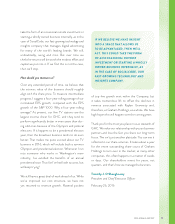Washington Post 2015 Annual Report Download - page 21
Download and view the complete annual report
Please find page 21 of the 2015 Washington Post annual report below. You can navigate through the pages in the report by either clicking on the pages listed below, or by using the keyword search tool below to find specific information within the annual report.The regulations also include revised requirements for public disclosure of program information and certain
outcomes (including graduation, placement, and repayment rates, and other consumer information); these new
disclosure requirements take effect on January 1, 2017. Until such time, schools must continue to make
disclosures pursuant to the disclosure provisions of the June 2011 final regulations, which remain in effect. The
regulations also contain reporting requirements under which schools must annually provide the ED with certain
information needed to compute the debt-to-earnings rates and several of the other disclosure elements. On
October 9, 2015, Kaplan University received a letter from the ED indicating that it had failed to report data on a
significant number of programs that were listed as active in the ED’s system. The letter stated that until the issue
is resolved, Kaplan University cannot start any new programs and failure to resolve the issue could result in
material administrative actions. Kaplan University has corrected the issue, but no assurances can be made that the
ED will accept those corrections, will not find additional issues or will not take further action against Kaplan
University.
In addition, the regulations include a “certification” requirement that each program subject to the regulations
(i) be approved by an accrediting agency recognized by the ED, (ii) have programmatic accreditation if required
by a governmental entity in a state in which the school is located or otherwise required to obtain state
authorization under ED’s regulations, and (iii) for each state in which the school is located or otherwise required
to obtain state authorization under the ED’s regulations, meet applicable educational prerequisites for
professional licensure or certification requirements in such state(s) so that graduates qualify to take any licensure
or certification exam that is needed for such graduates to practice or find employment in such state(s) in an
occupation that the program prepares graduates to enter. In addition, a school will be required to certify that any
new Title IV-eligible education program it establishes is not “substantially similar” (as defined in the GE
regulations) to a program that is ineligible under the regulations. This “certification” requirement has had a
material negative impact on Kaplan University’s Concord Law School’s Juris Doctor program, which accounted
for less than 1% of KHE’s 2015 revenue. Because it is completely online, that program does not have
accreditation necessary to allow graduates to become licensed to practice law upon graduation and qualify to take
the bar exam in any state other than California. Accordingly, because the ED has not provided guidance that
narrows the rule as written, in 2015 Concord Law School was required to cease enrollments in multiple states.
Changes in the state authorization law, discussed below, may extend the certification requirement to other states
and further impact our schools.
Some of the data needed to compute the debt-to-earnings rates and project their impact on program eligibility
under the GE regulations are not accessible to the Company, including graduate earnings information that will be
compiled by the Social Security Administration. In addition, the continuing eligibility of programs for Title IV
funding may be affected by factors beyond Kaplan’s control, such as changes in the actual or deemed earnings
level of its graduates, changes in student borrowing levels, increases in interest rates, changes in the U.S. Federal
poverty income level relevant for calculating one of the proposed debt-to-earnings rates and other factors. As a
result, the ultimate outcome of the GE regulations and their impact on Kaplan’s operations are still uncertain.
Kaplan is continuing efforts to mitigate the potential negative impact of GE. These efforts include increasing
career services support, implementing financial literacy counseling, creating program-specific tuition reductions
and scholarships and revising the pricing model to implement a tuition cap for at-risk programs. Although
Kaplan is taking these and other steps to address compliance with GE regulations, there can be no guarantee that
these measures will be adequate to prevent a material number of programs from either failing the debt-to-
earnings rates or being put on warning status. This has caused Kaplan to eliminate or limit enrollments in certain
educational programs at some or all of its schools; may result in the loss of student access to Title IV programs;
and has had a material adverse effect on KHE’s revenues, operating income, cash flows and the estimated fair
value of the reporting unit. The ED has indicated that the first debt-to-earnings rates to be calculated under the
new regulations are expected to be issued first in draft form later in 2016 and then in final form later in 2016 or
in early 2017.
Incentive Compensation.Under the incentive compensation rules as revised in 2011, an institution
participating in Title IV programs may not provide any commission, bonus or other incentive payment based
2015 FORM 10-K 6
























